Raising Water Consciousness through
World’s Biggest Photo Exhibition and
Largest collection of Photo Stories on Water
Photo Stories | Water and Culture
Water and Religion: Relevance of their Connection
Nandita Singh and Om Prakash Singh
16 August, 2017
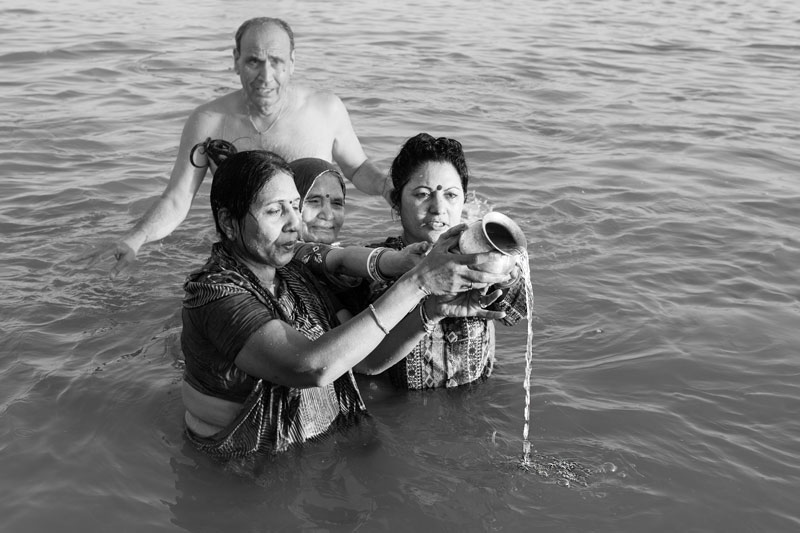
Culture as a system of shared beliefs, values, behavior and symbols that enables societal processes, has been seen as closely inter-twined with water. Religion, being an integral part of culture, shares this intricate relationship, as exemplified by the different religions practiced in India. Among the indigenous tribes, religion is intricately entwined with ideas about nature and interaction with local ecologies, water being a significant component. According to Sarna Dharam followed by the Munda in Jharkhand, Marang Buru (the Great Spirit) has the power of giving or withholding rain while the deity called Ikir Bonga presides over village tanks and wells. These deities must be propitiated to receive their blessings and ensure welfare. According to Islam, the second largest religion of India with over 172 million adherents (Census 2011), water is God's gift to humankind and therefore should not be sold or bought, nor be wasted or polluted. The holy Koran stipulates that water must be shared with others, and never withheld from the needy or poor. Among important water-related practices are mandatory ablutions with water before religious engagements in order to cleanse oneself physically and spiritually. In Christianity, the third largest religion of India followed by about 28 million people (Census 2011), it is believed that water was made on the first day of God's creation of the world, and brings life, heals, and washes away sins. Baptism is an important ritual associated with water which according to the Catholic Church annuls a person of sins. In Hinduism, which has the largest number of followers (over 966 million as per Census 2011), water occupies a special place. In general, nature is seen as a manifestation of the Almighty, with the whole universe, including humans, made up of five basic elements of nature of which Water is one and symbolizes the fluid mind. Also, life is seen to have begun in primordial water and nothing can exist in this world without it. It is regarded as the purifier, life-giver, and destroyer of evil. Sacred values are widely attached to water and several water sources including rivers, lakes, tanks and wells are regarded as sacred. Some of these, such as river Ganga, are symbolized as goddesses. Varuna is the god presiding over all rivers, streams, lakes, oceans and other water bodies, while Indra helps release rain from the clouds by producing thunder. Many Hindu rituals and practices are woven around water. Against the background of the nature of connections between water and religion drawn above, this photo story aims to not only portray these connections but also elaborate the relevance of these in the context of Hinduism. It further attempts to draw attention to the two-way relationship between them where water not only enables the practice of religion, helping connect society to the supernatural, but through the sacred concepts, beliefs and values connected to it, also serves to establish its secular value for society and enforce discipline, obliging human beings to value its importance as nature's gift and act to enhance its sustainability. The title photo depicts devotees praying and offering sacred waters of Sangam (the confluence of rivers Ganga, Yamuna and Sarasvati) to deities at Prayag (Allahabad), Uttar Pradesh.
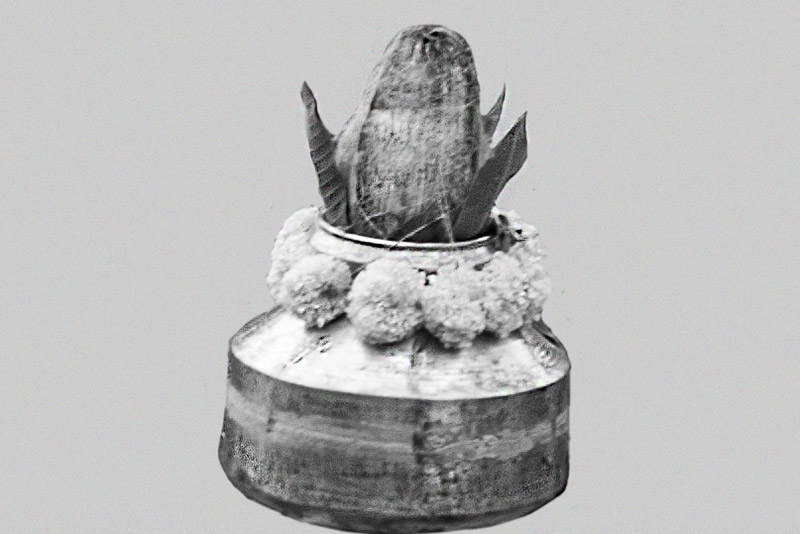
'Kalash' - a sacred pot filled with water and ritually adorned - at Trimbakeshwar in district Nashik, Maharashtra
The kalash epitomizes the centrality of water in Hinduism. A kalash is a metal (brass, copper, silver or gold) pot or an earthen pitcher with a large base and small mouth, most commonly filled with water and topped with a coronet of mango leaves and a coconut. It is considered a "symbol of abundance" and "source of life" and is supposed to be the first auspicious item to be ritually placed at a site of religious observance, including even daily worship at home or in the temple. Worship of the kalash is actually the first ritual on any such occasion and is mainly devoted to the god of water – Varuna. This worship is seen as beneficial for the family or society, bringing good luck, prosperity and harmony. The vacant pot symbolizes earth, and the water filled symbolizes the primordial water from which the entire creation emerged, thereby representing the life-giving ability of Nature. Sometimes, even the broad middle part of the pot is seen as symbolizing water. The primacy given to the worship of kalash and therefore of water god Varuna in any ritual in turn symbolizes the significance attributed to the forces of Nature in Hinduism, thereby helping reinforce society-nature ties.
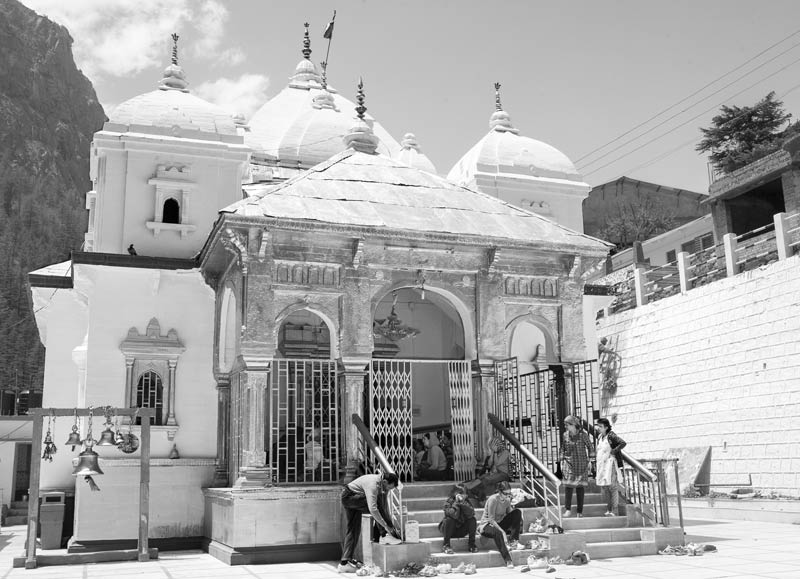
A temple dedicated to river goddess Ganga near its point of origin in the Gangotri glacier in Uttarkashi district, Uttarakhand
Rivers hold special significance in Hinduism, mostly associated with sacred qualities. Seven rivers - Ganga, Yamuna, Sarasvati, Narmada, Kshipra, Godavari and Kaveri - are particularly considered as sacred or holy. Personified as goddesses, a holy bath in the waters of these rivers is believed to purify the body and soul and absolve from all sins. The points of origin of these holy rivers are considered as centers of pilgrimage and many holy places/pilgrimage centers and hundreds of temples are situated along their banks. Ganga is considered to be the most sacred of all and regarded as 'mother', often taken to symbolize purity and spirituality. The river originates at Gaumukh in Gangotri glacier in the Himalayas as river Bhagirathi. She is worshipped as a goddess in a temple built in white marble at Gangotri, a pilgrimage town situated 19 km away from Gaumukh on the river banks. In the Hindu iconography, goddess Ganga is depicted as a fair complexioned beautiful lady wearing a white crown with a water lily and a water pot in her hands, and riding a crocodile. According to Hindu mythology, Ganga descended on Earth at the request of king Bhagirath for salvation of his 60,000 ancestors, hence the name Bhagirathi. Bhagirath performed long penance at Gangotri for receiving Ganga's blessings who first descended from heaven into the matted hair of Lord Shiva in the Himalayas, and then came further down to flow on Earth.
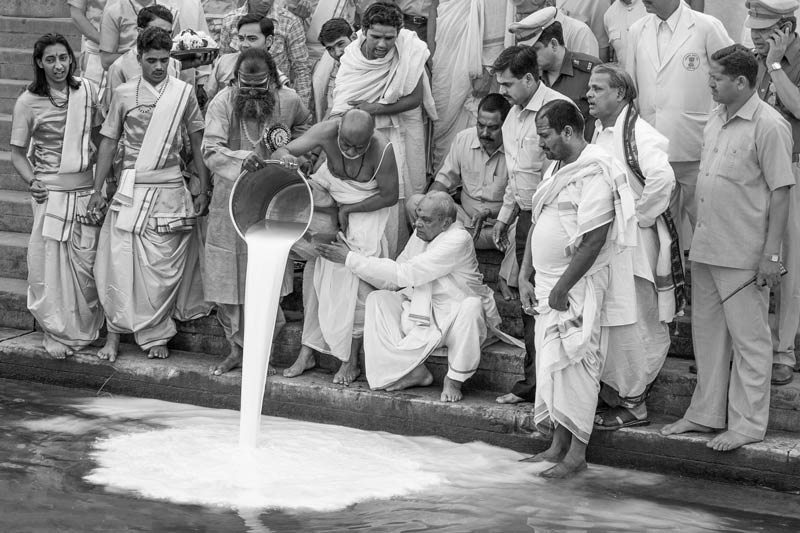
River Ganga being worshipped at Dashashwamedh Ghat in Varanasi, Uttar Pradesh
Ganga flows over a distance of more than 2,500 km, enriching the spiritual lives of the millions of Indians for whom the river is divine and nourishing those who live along her banks in the Great North Indian Plains. She is respectfully referred to as 'Gangaji' or 'Ganga Maiya' (Mother Ganga). The river is inscribed profusely in the Hindu religious scriptures, particularly the Vedas, the Puranas and the two Indian epics, the Ramayana and the Mahabharata. River Ganga is worshipped all along her course, the principle centers being Gangotri, the source of the river; Haridwar, where she comes down to the plains; Prayag (Allahabad), where she joins the Yamuna and mythical Sarasvati; Varanasi, the holy city; and finally in the estuary at Sagara Island where she flows into the Bay of Bengal. These places have developed as great pilgrimage centers visited by not only Indian Hindus but even by international pilgrims. In the photo above, the river is being worshipped by an ex-Governor of Madhya Pradesh, helped in the ritual by priests of Varanasi. He is offering milk to the river, accompanied by chanting of Vedic hymns.
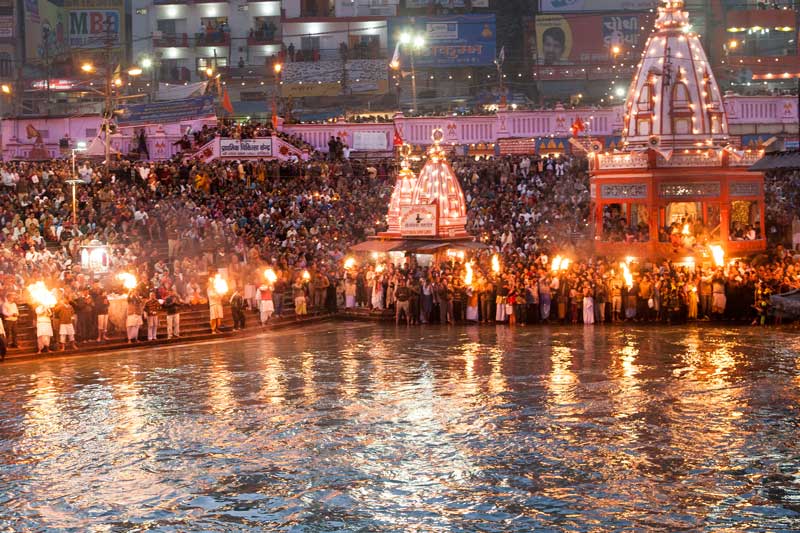
Evening 'aarti' of river Ganga at Haridwar, Uttarakhand
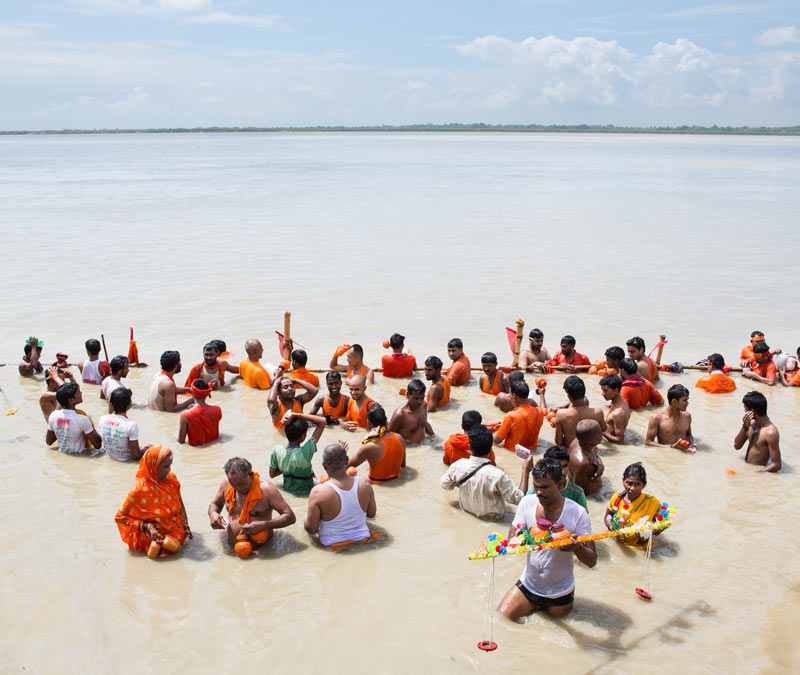
Pilgrims taking holy bath in river Ganga and collecting the sacred water in pots at Sultanganj in district Bhagalpur, Bihar
During the Hindu month of Shravan (July-August), many devotees of Shiva undertake an annual pilgrimage called kanwar yatra. These pilgrims are called kanwarias and during this pilgrimage they fetch sacred water from the Ganga, carrying it across hundreds of kilometers for later performing jalabhisheka (pouring water or anointing with water) on Shiva Linga at specific temples such as Kashi Vishwanath at Varanasi, Baba Baidyanath Dham in Deoghar, Pura Mahadeva in Baghpat and Augharnath temple in Meerut, or even in their local Shiva shrines. Kanwarias heading to offer sacred water at Baba Baidyanath Dham take holy water from river Ganga at Sultanganj which is regarded as an auspicious spot since here the river is uttarvahini (flowing from south to north) for half a kilometer. They first take holy bath in the river and then fill the sacred water in small pots.
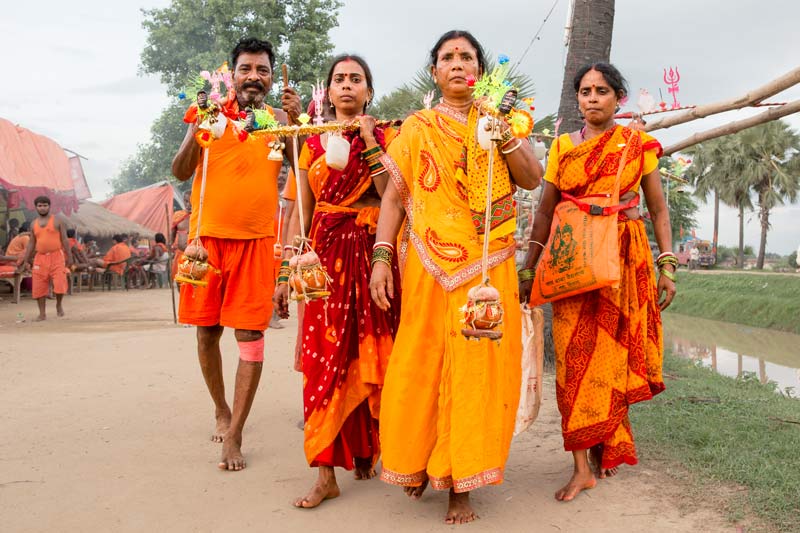
Kanwarias carrying the holy Ganga water in ‘kanwars’ for offering to Lord Shiva in Bhagalpur district, Bihar
Kanwarias follow a dress code that reflects devotion, with men mostly clad in saffron clothes and women in yellow or saffron sarees, During the entire trip, they are supposed to renunciate all kinds of worldly things, including bed, comb, soap and oil, and move barefoot. They carry the sacred water in kanwar which consists of a single pole (usually made of bamboo) with two roughly equal loads fastened or dangling from opposite ends. Pots of water hangiing at the two ends constitute the load. Maintaining purity of the water contained in the pots is of extreme significance and for this reason, a kanwar cannot be put down on the ground. To facilitate this requirement, arrangements are made alongside the path taken by the kanwarias. It is estimated that more than 5 million devotees come Sultanganj for collecting holy water from Ganga River, a great majority of whom undertake the journey upto Baba Baidyanath Dham. Some devotees travel by bus, car or motorcycle, while some others vow to cover the entire distance going non-stop and reaching the temple in less than 24 hours. The total distance from Sultanganj to Baidynath Dham is 105 km by the old route and 90 km by the new shortcut way.
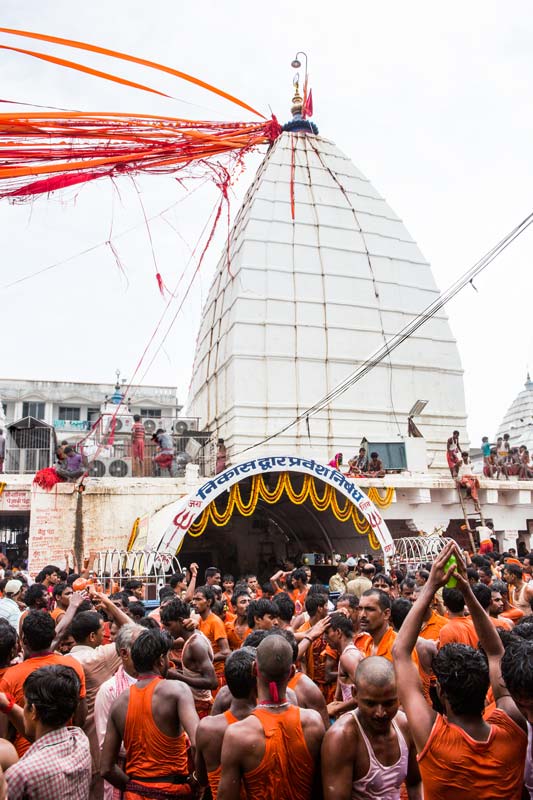
Kanwarias rejoicing and paying respect outside the temple at Baba Baidyanath Dham after offering holy Ganga water on the Jyotirling in district Deoghar, Jharkhand
Shravan is regarded as a holy month because according to Hindu legend, it was during this period that the deadly poison – halahal - emerged from Samudra Manthan, the mythical ocean churning, which had the power to spread and destroy the creation. On the request of all gods, in a bid to save all life, Lord Shiva drank all the poison and conserved it in his throat. But the magnitude of toxicity of halahal was tremendous and its heat was enormous, causing burning sensation and turning Shiva’s throat blue for which he is given the name “Neelkanth”. So in order to calm down its impact on Shiva the gods performed Ganga Abhishek on him, hence the beginning of this practice. Devotees offer Ganga water as an expression of gratitude for this benevolent act and seek Lord Shiva's blessings. Baba Baidyanath Dham is one of the 12 jyotirlingas, the most sacred abodes of Shiva. Given the importance of this temple, it is visited by kanwarias and numerous other devotees during Shravan and at other times, the former offering Ganga water fetched from Sultanganj at the jyotirlinga.
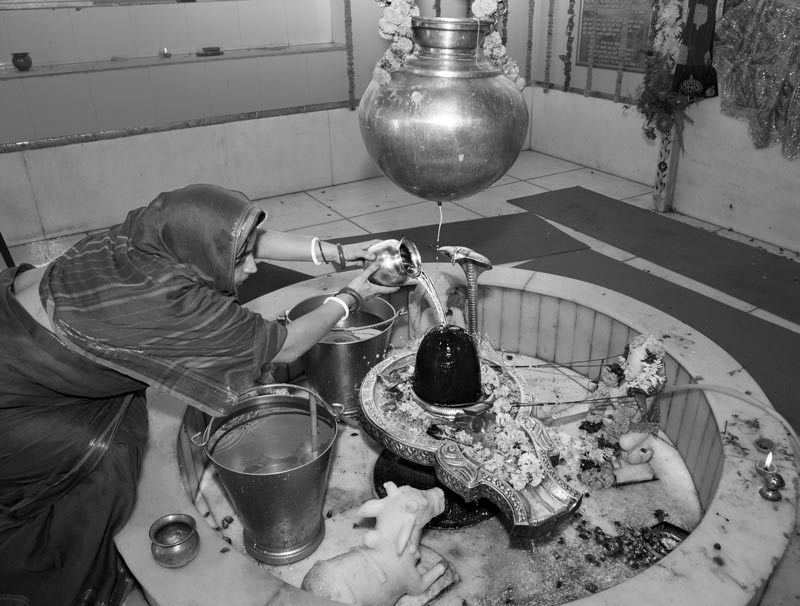
A devotee performing jalabhisheka at Shiva Linga in a temple during the holy month of Shravan in South-East district, National Capital Territory of Delhi
The month of Shravan is dedicated to Lord Shiva and during the entire month, jalabhisheka is performed across the country at Shiva temples by hundreds of devotees every day, Monday being considered especially auspicious. Otherwise too, throughout the year, on Mondays and even other days, devotees make an offering of water on Shiva Linga at the temples or even during worship at home as an act of gratitude, commemorating the benevolence of Lord Shiva and seeking his blessings. Underlying this ritualistic practice lies a scientific reason. Shiva is the destroyer of impurity and even the worst kind of energies get purified with his grace. Wherever Shiva Linga is established and worshipped, bad energy in the atmosphere, which is also hot, travels through it and gets cleaned. However, the hot energy in turn heats up the Shiva Linga which consequently needs to be continuously cooled by pouring water. Further, at a more subtle level, bad karma (actions) by a person affects the water element of the body which absorbs the bad energy of that karma. When water is poured on Shiva Linga while thinking of Shiva, this affected water element inside the body gets purified leading to upliftment of mind, body and soul. On the whole, pouring water on Shiva Linga is connected to the purification of the earth, the body, and the thinking.
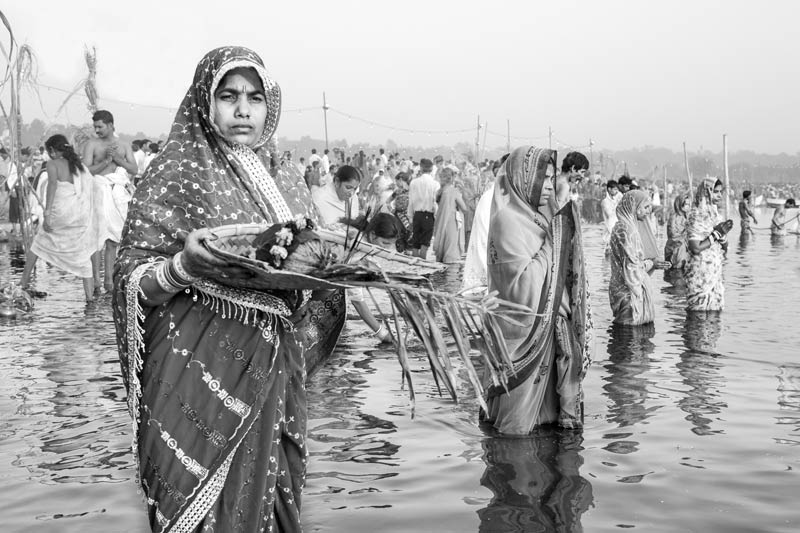
Devotees offering ‘arghya’ on the banks of river Yamuna during Chhath Puja celebrations in North-East district, National Capital Territory of Delhi
An important ancient Hindu Vedic religious festival where water plays an important role is Chhath Puja. This festival is dedicated to Sun god, who is worshipped along with his wives – goddesses Usha and Pratyusha, commonly referred to as ‘Chhath Maiya’. Originally a festival celebrated mainly in Bihar, Jharkhand and Uttar Pradesh, it is now also observed in many other parts of India. It is a festival celebrated with great austerity through a period of 4 days during the Hindu month of Kartik (October-November), the major worship being performed on the 3rd day which happens to be the 6th day of the month, and hence the name ‘Chhath’. It is also celebrated similarly during Chaitra month (March-April). Devotees perform worship to thank the Sun god for supporting life on earth and seek his protection and blessings. It is believed that Usha brings light, symbolizing the dawn of divine consciousness in the individual aspirant, and she is worshipped along with Sun god on the last day at dawn, while Pratyusha is worshipped as the last sun-ray of day at dusk on the third day, thanking her for supporting life. Though there are many observances and rituals connected with Chhath Puja, looking at the connections with water, it is noteworthy that this festival is celebrated on the bank of a river, pond or other sources of water, where holy bath is taken, and offering of sacred water and Prasad - comprising of thekua (made of flour, sugar or jaggery), sugarcane with green leaves, Gagal (a variety of big Lemon-species), cardamom, green ginger, coconut, banana, orange,and other seasonal fruits – is made to the setting and rising sun along with goddesses Pratyusha and Usha respectively. This process is called offering of arghya and is undertaken while standing in water, preferably with half the body immersed. Besides devotees also meditate and pray for long periods of time standing in water.
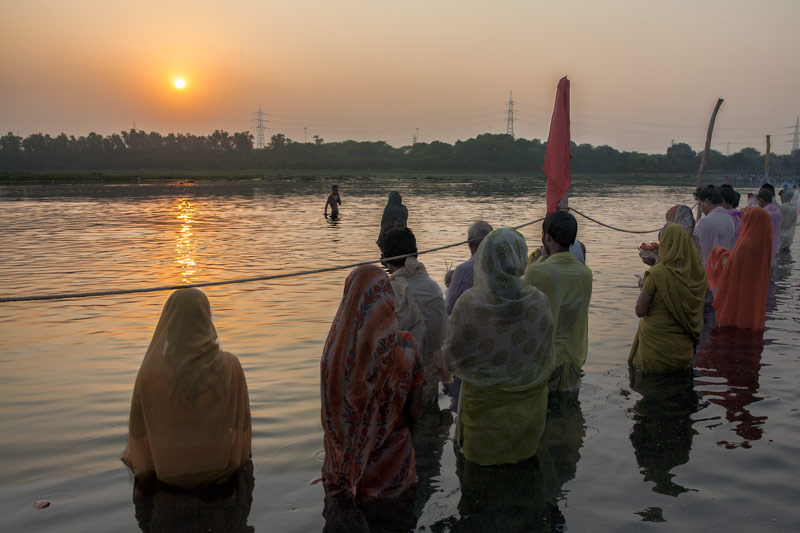
Devotees praying and meditating while standing in the waters of river Yamuna during Chath Puja celebrations in North-East district, National Capital Territory of Delhi
Performance of Chhath worship while standing in water with about half the body immersed is important as it brings the benefit of minimizing the leak of energy from the body and helps the prana (psychic energy) to move up the sushumna (psychic channel in the spine). Thereafter cosmic energy enters the devotee’s pineal, pituitary and hypothalamus glands (called Triveni complex) through retina and optic nerves, transforming his/her body into a cosmic powerhouse which then conducts, recycles and transmits the energy into the entire universe. The offering of water made to the Sun god on the occasion of Chhath and also as a regular daily worship, has a special significance too. When the spectrum of sun rays refract through the water, it breaks down into seven colors. The energy emanating from these rays of different colors is absorbed by the body, which helps in intellectual upliftment of the devotee and also enhances his wisdom in decision-making, eye-sight, digestion, luster as well as splendor. Ultra-violet radiation helps treat various diseases. Hence, there is a popular belief that worshipping Sun god will help in curing diseases like leprosy and also ensure longevity and prosperity of the family.
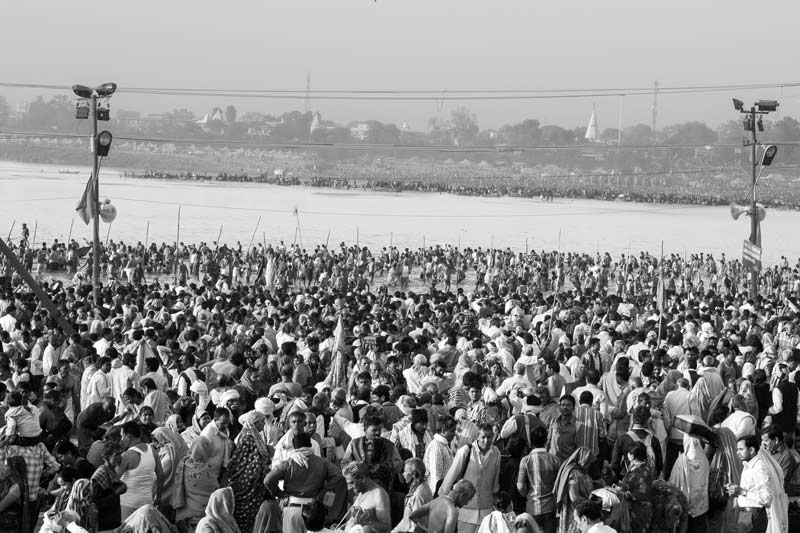
Teeming millions performing sacred bath during Kumbh at Prayag (Allahabad), Uttar Pradesh
Since water has cleansing powers and is also ascribed values of purity and spirituality in Hinduism, taking a holy bath in the sacred rivers is believed to cleanse the devotees of all sins and pave the way for heaven or even salvation (moksha) after death. As a result, many Hindus visit pilgrimage centers located along the banks of Ganga and other holy rivers on a number of auspicious occasions and take a holy bath (snan). Important annual occasions include Kartik Purnima and Makar Sankranti, but the oldest and most well-known ritual bathing festival of India is Kumbh, known to be performed perhaps since Rig Vedic times (1700-1100 BCE). Kumbh has four venues, namely Haridwar, Ujjain, Nashik and Prayag (Allahabad) along the sacred rivers Ganga, Godavari, Kshipra and at the confluence (sangam) of Ganga, Yamuna and Sarasvati respectively, being held at the same place every 12 years. It is said that a drop of immortal nectar was dropped in the rivers at each of these locations as Gods and demons fought over a pot (kumbh) holding the nectar, the pot having emerged after churning of the eternal ocean. The battle lasted 12 days for the Gods which equals 12 years in human time, hence Kumbh is held at the same venue every 12 years. Kumbh is world’s largest peaceful religious congregation where teeming millions from all corners of India and abroad undertake the Kumbh Snan - holy bath in sacred river water. Apart from the importance of Kumbh Snan at sangam in Prayag, the confluence itself is considered as a pilgrimage centre and having bath here is always considered very auspicious since three holy rivers meet here.
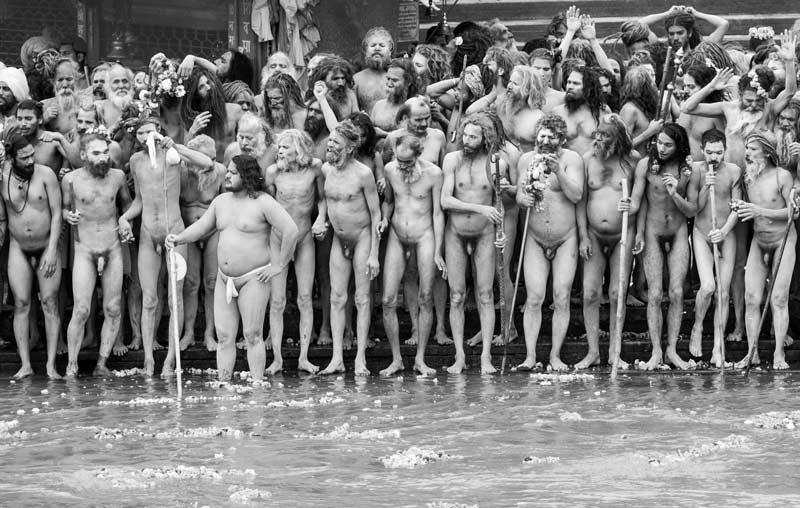
Naga Sadhus lining up for undertaking Royal Bath (Shahi Snan) during Kumbh at Har-ki-Pauri in Haridwar, Uttarakhand
Kumbh Snan enables not only purification of the body and soul, but also believed to enable liberation from sins, and emancipation from the cycle of re-births and death (moksha). This is because of special zodiac alignments during the Kumbh. Kumbh is held at Haridwar when the Jupiter enters the zodiac sign Aquarius or Kumbh and Sun and Moon in Aries and Saggittarius respectively. When Jupiter is in Taurus or Vrishabha and the Sun and Moon are in Capricorn or Makra, the Kumbh is held at Prayag (Allahabad). When the Jupiter enters the zodiac sign Simha and the Sun and Moon in Cancer, Simhastha Kumbh is held at Nashik-Trimbakeshwar. When Jupiter is in Leo and the Sun and Moon in Aries, Kumbh is held at Ujjain. These special zodiac alignments trigger the holy waters of the sacred river with Cosmic Energy that effects a change in the mind, body and spirit, thereby affecting the human destinies for the better. An important dimension of the Kumbh Snan is the Royal Bath (Shahi Snan) which is organized on certain specific auspicious dates. On this occasion all Hindu akharas (religious congregations where followers live lives of complete renunciation) proceed in a grand procession for the bath. At shahi snan, the Naga Sadhus (naked ascetics) occupy a place of privilege and initiate the bathing rituals. The other important persons are the Mahamandaleshwars (highest Hindu spiritual guardians) and other monks and leaders of the Akhara. All holy persons offer prayers to the river and God Almighty and take the holy bath. Only after shahi snan of the akharas is over can the general public step in for the holy bath on these special dates.

Naga Sadhus performing shahi snan at Har ki Pauri, Haridwar, Uttarakhand
Har ki Pauri (steps of Lord Hari), where Brahma Kund (sacred tank of Almighty) is located, is the most auspicious spot in Haridwar, and the venue of Shahi Snan during Kumbh celebration. According to Hindu mythology, when goddess Ganga agreed to descend to Earth from the Heaven, she was concerned about losing her sanctity due to sinful people bathing in her waters, sullying her with bad karma. But the noble Bhagirath, praying for the salvation of his ancestors' souls, assured Ganga that there are as many sacred and devoted souls on Earth as there are sinners, by whose contact all the sin acquired from the sinners will be removed. The Naga Sadhus belong to this genre and help mother Ganga restore her purity.
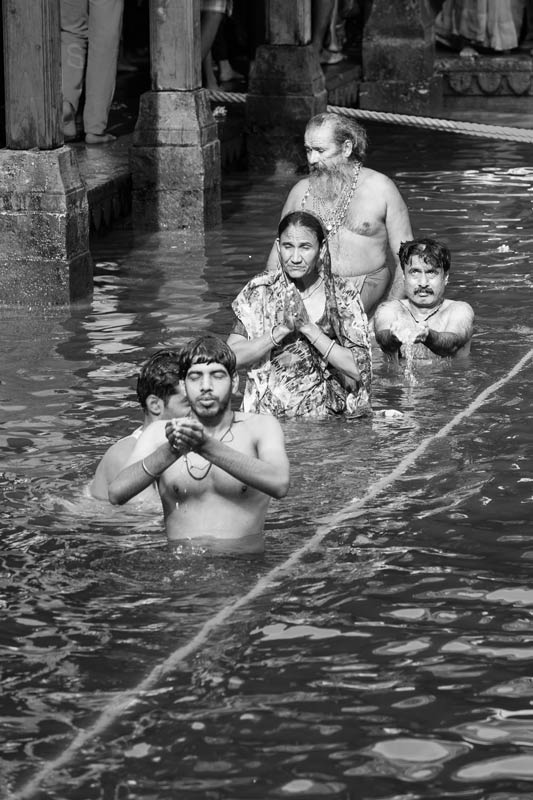
Devotees engaged in Kumbh Snan at Kushavarta Ghat, Trimbakeshwar during Nashik Kumbh, Maharashtra
Godavari originates from the Brahmagiri Mountain at Trimbakeshwar and Kushavarta is the spot from where it takes its course. A bath in the sacred river at this spot is believed to wipe off all sins. The sage Gautam, who committed the sin of murdering a cow, wiped off his sin by taking bath in this river here. Kushavarta is one of the two venues along Godavari where devotees undertake holy bath during the Nashik Kumbh. The other venue is Ram Kund in Nashik. Apart from the occasion of kumbh, holy bath is taken at both these venues on occasions like Kartik Purnima or otherwise, with a desire to achieve purity and be absolved of all sin. According to Hindu belief, bathing in rivers and water reservoirs where water is flowing can create radiance in a dormant state from the sound (arising out of flowing of the water) in turn causing the conscious and subconscious minds in the body to awaken and get purified, ultimately assisting the body in absorbing the sattvik (quality of righteousness and goodness) waves from the atmosphere with ease. Bathing in sacred water sources multiplies this effect and preconditions the mind and body to perform a religious act.
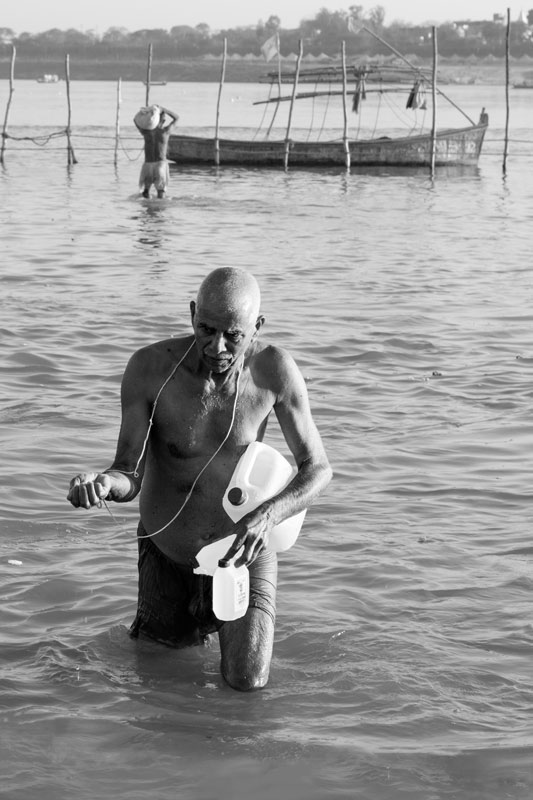
A pilgrim obtaining sacred water at the confluence of rivers Ganga, Yamuna and Sarasvati at Prayag (Allahabad), Uttar Pradesh
River Ganga is a symbol of purity in Hinduism. Her water, called Gangajal, is regarded as extremely pure and sacred. According to the holy scriptures called Puranas, the sight, the name, and the touch of Ganga cleanses one of all sins. Ganga water is collected in containers and carried far and wide for use in temples, holy places and even at home for religious and ritual observances. It is believed that even one drop of the holy water can purify persons and objects alike and is enough to wipe out all the sins accumulated over many lifetimes. Holding this water in hand Hindus are not expected to lie or be deceitful. Hindus believe that performance of a ritual near river Ganga multiplies in its blessedness. Similar sacred values are attached to the waters from the other six holy rivers, though Ganga is considered to be the supreme. In the above photo sacred water taken from the confluence (sangam) is believed to be even more important since it combines the virtues of 3 holy rivers – Ganga, Yamuna and Sarasvati.
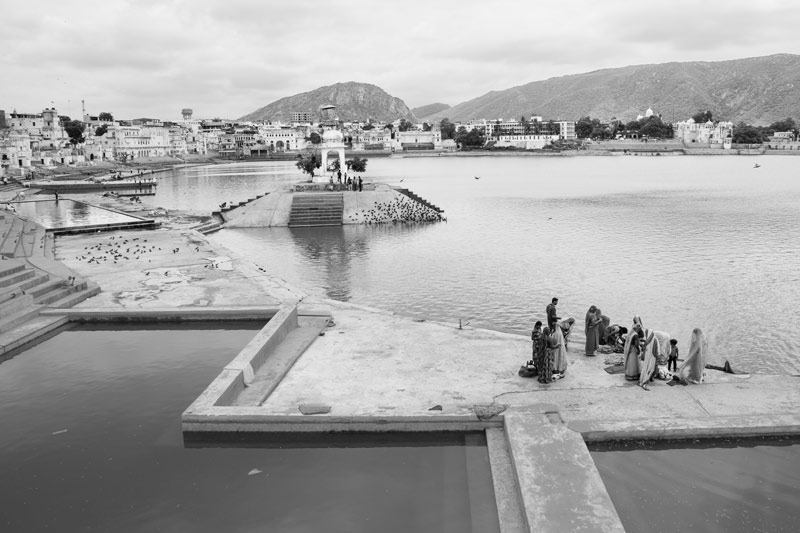
Holy Pushkar Lake in district Ajmer, Rajasthan
Pushkar, often called "Tirtha-Raj" – the king of pilgrimage sites related to water-bodies, is considered one of the most sacred places in India, being one of the five sacred lakes collectively called Panch-Sarovar. It is surrounded by 52 ghats which are bathing platforms and series of steps leading into the water. Devotees throng the Lake in large numbers to take a sacred bath and perform a number of rituals dedicated to God as well as their ancestors. A holy bath in the sacred waters of Pushkar is believed to wash away all sins for the sake of salvation of the soul (moksha) and also cure skin diseases. Further, it is a belief that a bath in the Lake on Kartik Poornima (full moon of Kartik month) would equal the benefits that would accrue by performing yagnas (fire-sacrifices) for several centuries. Over 500 Hindu temples are situated in the lake premises. An important aspect of the rituals performed at Pushkar includes the last rites for the deceased and ancestors, namely, Shraadh, Tarpan and Pind Daan, the latter believed to lead to attainment of moksha or the liberation from the cycle of birth and rebirth. According to Hindu mythology, the Lake came into being from the navel of Vishnu or when Brahma dropped a Lotus flower in order to save his creation from the attack of a demon called Vajranabha. Apart from its religious significance, the Lake also acts as a source of groundwater recharge in the area, enabling people access to water in a hot semi-arid climate.

A sacred tank - called Ambalakulam - at Ambalappuzha Sri Krishna Temple in Alappuzha district, Kerala
Since water plays a pivotal role in Hindu rituals, many of the temples and sacred places have water bodies associated with them. These could be rivers, lakes, tanks or even wells. Sacred tanks associated with temples are a widespread phenomenon in villages of southern India and these are variously referred to as kalyani, kulam, tirtham, cheruvu or pushkarani. The water from these tanks has been traditionally used by priests for ritual cleansing, for ritual bath of the deity and other temple rituals, cleaning of temple premises, physical purification by devotees before entering the temple, and sometimes even for irrigating temple lands. In addition to the specific ritual/sacred functions, in many cases sacred tanks provide drinking water to local communities and help maintain varied flora, including medicinal plants of great value for primary health care in the local community. Very importantly, these also act as percolation tanks, helping maintain the groundwater levels, thus ensuring sufficient water in the domestic wells in the vicinity. Sacred tanks vary in size and shape and are a masterpiece of engineering. Corridors and long flights of steps surround them. They have intricate inlet channels for bringing water from a stream or river and outlets that carry away the excess water. Some have natural springs in their bed and others have wells that can be accessed when the tank is dry. The Ambalakulam at Sri Krishna Temple shown in the photo above is used by devotees for ritual cleansing before offering worship at the temple and its banks traditionally serve as the stage for performance of Velakali - a unique martial dance form performed during temple festival in the Meenam month of the Malayalam calendar (March-April).
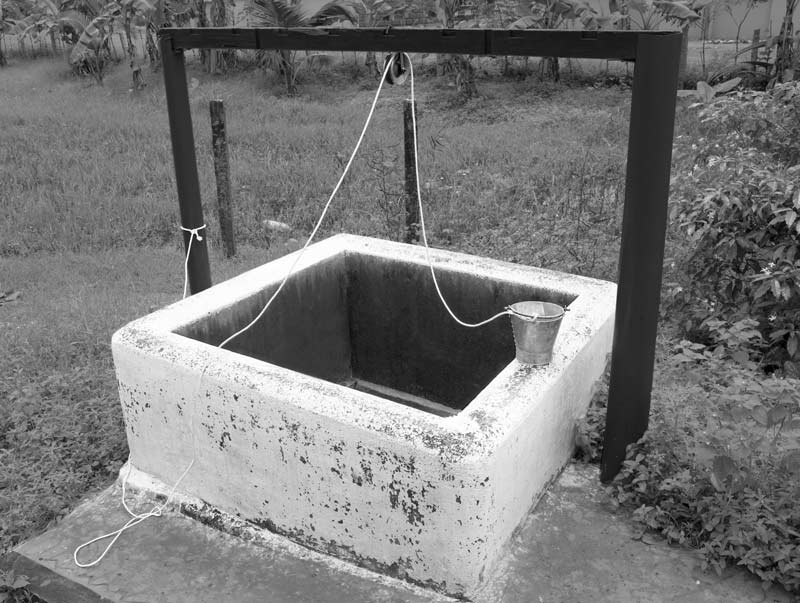
A sacred well at Bhagwati temple in Alappuzzha district, Kerala
Wells in India have been largely considered as sources of pure water and well water, if available, is often preferred for ritual use over other sources like handpump and tap water. Wells may be present within or next to temple premises where the water is used for ritual cleansing before entering the temple and offering worship. In many temples in south India, wells exist alongside sacred tanks for use by devotees or for procuring water for different temple uses. In Kerala, these wells are called mani-kenar. At the Ambalapuzzha temple too, besides the sacred tank, there also exists a sacred well which is used as a source of water for preparing the special offering made to the god. According to holy scriptures, digging a well or a pond is a noble and religious act, about which goddess Parvati is believed to have said that “One who digs a well where there is little water lives in heaven for as many years as there are drops of water in it. One large reservoir of water is worth ten wells”. Wells are considered auspicious and while starting a journey sight of the well is believed to be auspicious.
Through the example of Hinduism, this photo story elaborates how closely water and religion are interconnected. Religion as a system of concepts, beliefs, practices and symbols serves to connect human beings with the sacred or the supernatural. Further, as elaborated in the context of Hinduism, the supernatural beings are personified forms of different forces of nature, with water being perceived as the basis of creation and life. The connections between water and religion in turn relate to many practical aspects of human life and society. The nature of connections between water, religion and society is actually recurrent across different religions practiced in India. From this perspective, the interconnection between the three can be conceptualized as the “water-religion-society” continuum. Within this continuum, attachment of sacred value to water and water sources, perception of its presence on Earth as a divine gift, etc. places the obligation upon society to protect and sustain water so that the creation itself can be sustained. Similarly, deification of water as a god symbolizes its importance for human society, while the attribute of purity attached to sacred rivers, water bodies or river goddesses further symbolizes the necessity of upholding the water quality as in its pristine state. At a pragmatic level, the observance of religious rituals and practices require uninterrupted availability of clean and pure water. These sacred water needs necessitate proper maintenance of sacred water bodies such as rivers, lakes, tanks, etc., which in turn has a wider relevance since this enables water sustainability at a larger scale such as through maintenance of rivers and lakes and percolation of the surface water for groundwater recharge, in turn making clean water available in wells for sacred and secular uses (like drinking and irrigation). Further, as exemplified in the story, many of the ostensibly religious rituals connected with water have scientific basis and aim to help individuals achieve better physical and spiritual health, in turn fostering healthier society. The various connections between water and religion can be further seen as a way to inculcate discipline in society towards the protection and sustainable use of water resources for sacred as well as secular purposes. This discipline is inculcated in the masses either through the component of ‘fear’ of negative consequences if religious norms and duties related to water are violated, or though that of ‘respect’ where these religious norms and duties are automatically followed out of reverence. Religious beliefs, values and practices connected with water are thus not merely confined to the supernatural sphere but has scientific basis behind them and helps society secure water for all purposes and sustain its existence. Therefore the bond between water and religion should be respected, strengthened and passed on to future generations, so that proper harmony between nature and society can be maintained and human civilization can continue to flourish.